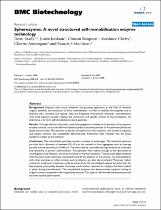JavaScript is disabled for your browser. Some features of this site may not work without it.
- ResearchSpace
- →
- Research Publications/Outputs
- →
- Journal Articles
- →
- View Item
| dc.contributor.author |
Brady, D

|
|
| dc.contributor.author |
Jordaan, J

|
|
| dc.contributor.author |
Simpson, C

|
|
| dc.contributor.author |
Chetty, A

|
|
| dc.contributor.author |
Arumugam, C

|
|
| dc.contributor.author |
Moolman, FS

|
|
| dc.date.accessioned | 2009-01-08T07:53:34Z | |
| dc.date.available | 2009-01-08T07:53:34Z | |
| dc.date.issued | 2008-01-31 | |
| dc.identifier.citation | Brady, D, Jordaan, J, Simpson, C et al. 2008. Spherezymes: A novel structured self-immobilisation enzyme technology. BMC Biotechnology, Vol. 8(8), pp 11 | en |
| dc.identifier.issn | 1472-6750 | |
| dc.identifier.uri | http://www.biomedcentral.com/1472-6750/8/8 | |
| dc.identifier.uri | http://hdl.handle.net/10204/2770 | |
| dc.description | This is an Open Access article distributed under the terms of the Creative Commons Attribution License (http://creativecommons.org/licenses/by/2.0), which permits unrestricted use, distribution, and reproduction in any medium, provided the original work is properly cited | en |
| dc.description.abstract | Enzymes have found extensive and growing application in the field of chemical organic synthesis and resolution of chiral intermediates. In order to stabilise the enzymes and to facilitate their recovery and recycle, they are frequently immobilised. However, immobilisation onto solid supports greatly reduces the volumetric and specific activity of the biocatalysts. An alternative is to form self-immobilised enzyme particles. Through addition of protein cross-linking agents to a water-in-oil emulsion of an aqueous enzyme solution, structured self-immobilised spherical enzyme particles of Pseudomonas fluorescens lipase were formed. The particles could be recovered from the emulsion, and activity in aqueous and organic solvents was successfully demonstrated. Preliminary data indicates that the lipase tended to collect at the interface. The immobilised particles provide a number of advantages. The individual spherical particles had a diameter of between 0.5–10 μm, but tended to form aggregates with an average particle volume distribution of 100 μm. The size could be controlled through addition of surfactant and variations in protein concentration. The particles were robust enough to be recovered by centrifugation and filtration, and to be recycled for further reactions. They present lipase enzymes with the active sites selectively orientated towards the exterior of the particle. Co-immobilisation with other enzymes, or other proteins such as albumin, was also demonstrated. Moreover, higher activity for small ester molecules could be achieved by the immobilised enzyme particles than for free enzyme, presumably because the lipase conformation required for catalysis had been locked in place during immobilisation. The immobilised enzymes also demonstrated superior activity in organic solvent compared to the original free enzyme. This type of self-immobilised enzyme particle has been named spherezymes | en |
| dc.language.iso | en | en |
| dc.publisher | BioMed Central Ltd | en |
| dc.subject | Spherezymes | en |
| dc.subject | Self-immobilisation enzyme technology | en |
| dc.subject | Enzymes | en |
| dc.subject | Pseudomonas fluorescens | en |
| dc.subject | Lipase enzymes | en |
| dc.title | Spherezymes: A novel structured self-immobilisation enzyme technology | en |
| dc.type | Article | en |
| dc.identifier.apacitation | Brady, D., Jordaan, J., Simpson, C., Chetty, A., Arumugam, C., & Moolman, F. (2008). Spherezymes: A novel structured self-immobilisation enzyme technology. http://hdl.handle.net/10204/2770 | en_ZA |
| dc.identifier.chicagocitation | Brady, D, J Jordaan, C Simpson, A Chetty, C Arumugam, and FS Moolman "Spherezymes: A novel structured self-immobilisation enzyme technology." (2008) http://hdl.handle.net/10204/2770 | en_ZA |
| dc.identifier.vancouvercitation | Brady D, Jordaan J, Simpson C, Chetty A, Arumugam C, Moolman F. Spherezymes: A novel structured self-immobilisation enzyme technology. 2008; http://hdl.handle.net/10204/2770. | en_ZA |
| dc.identifier.ris | TY - Article AU - Brady, D AU - Jordaan, J AU - Simpson, C AU - Chetty, A AU - Arumugam, C AU - Moolman, FS AB - Enzymes have found extensive and growing application in the field of chemical organic synthesis and resolution of chiral intermediates. In order to stabilise the enzymes and to facilitate their recovery and recycle, they are frequently immobilised. However, immobilisation onto solid supports greatly reduces the volumetric and specific activity of the biocatalysts. An alternative is to form self-immobilised enzyme particles. Through addition of protein cross-linking agents to a water-in-oil emulsion of an aqueous enzyme solution, structured self-immobilised spherical enzyme particles of Pseudomonas fluorescens lipase were formed. The particles could be recovered from the emulsion, and activity in aqueous and organic solvents was successfully demonstrated. Preliminary data indicates that the lipase tended to collect at the interface. The immobilised particles provide a number of advantages. The individual spherical particles had a diameter of between 0.5–10 μm, but tended to form aggregates with an average particle volume distribution of 100 μm. The size could be controlled through addition of surfactant and variations in protein concentration. The particles were robust enough to be recovered by centrifugation and filtration, and to be recycled for further reactions. They present lipase enzymes with the active sites selectively orientated towards the exterior of the particle. Co-immobilisation with other enzymes, or other proteins such as albumin, was also demonstrated. Moreover, higher activity for small ester molecules could be achieved by the immobilised enzyme particles than for free enzyme, presumably because the lipase conformation required for catalysis had been locked in place during immobilisation. The immobilised enzymes also demonstrated superior activity in organic solvent compared to the original free enzyme. This type of self-immobilised enzyme particle has been named spherezymes DA - 2008-01-31 DB - ResearchSpace DP - CSIR KW - Spherezymes KW - Self-immobilisation enzyme technology KW - Enzymes KW - Pseudomonas fluorescens KW - Lipase enzymes LK - https://researchspace.csir.co.za PY - 2008 SM - 1472-6750 T1 - Spherezymes: A novel structured self-immobilisation enzyme technology TI - Spherezymes: A novel structured self-immobilisation enzyme technology UR - http://hdl.handle.net/10204/2770 ER - | en_ZA |






